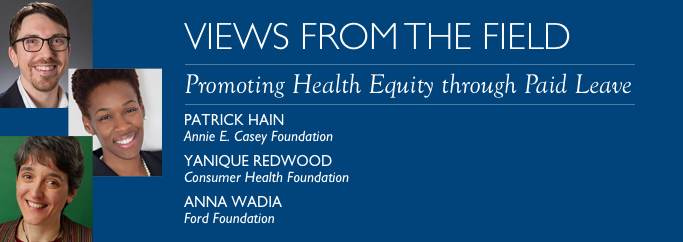
Universal paid family and medical leave promotes health equity by improving health and well-being across the life span and reducing socioeconomic disparities. Benefits provide partial wage replacement so that workers can take time off to care for a new baby or adopted or foster child, or to care for themselves or a family member in case of serious illness or injury. Existing state programs are publicly administered and financed by very small employee contributions.
|
Primer on Paid Family and Medical Leave Insurance and Paid Sick Days Paid family and medical leave insurance and paid sick days are different but complementary types of paid time that can be used to attend to the care and health needs of oneself or family members. Both are essential to health and equity. Paid Sick Days
Paid Family and Medical Leave Insurance
|
The United States is the only advanced industrialized country that does not offer some form of government-sponsored paid leave. Since 1993, the federal Family and Medical Leave Act (FMLA) has provided up to 12 weeks of unpaid, job-protected leave annually to about 60 percent of the workforce, primarily employees of larger companies. Because the leave is unpaid, most low-wage workers cannot afford to take it. Only 14 percent of United States employees have access to paid family leave through their employers. The workers who most need and could most benefit from paid family and medical leave – low-wage workers, particularly workers of color and immigrants – are the least likely to have access to it.
But four states – California, New Jersey, Rhode Island, and New York– have enacted paid family leave by building on their temporary disability insurance programs (Washington State passed paid parental leave legislation in 2007, but the law was not implemented because of a lack of a funding mechanism. A coalition of advocates is working to secure a broader family and medical leave program in 2017). Campaigns to expand access to paid leave are underway in numerous other states and at the federal level.
The Health Benefits of Paid Leave
“Infancy is a critical period for child health and development. The American Academy of Pediatrics supports legislation providing 12 weeks of paid family leave, but I must stress that this is really a very modest minimum. Research tells us that while at least 12 weeks of paid leave is essential, there are dividends the longer it is.”
—Benard P. Dreyer, MD, FAAP; President, American Academy of Pediatrics
Paid family leave improves the health and well-being of both parents and children by:
- allowing mothers to rest and recover after childbirth,
- reducing infant mortality,
- extending the length of breast feeding,
- increasing the frequency of well-baby visits and vaccination rates, and
- reducing toxic stress in young children by improving parental mental health.
Having paid family leave also strengthens parent-child bonding, which promotes healthy child development, alleviates maternal depression, and fosters better father-child relationships.
Paid leave also provides workers with time to care for a family member who is seriously ill, or has special needs, or to recover from their own serious illness. With paid leave:
- a mom can be with her son while he is undergoing chemotherapy for lymphoma,
- a daughter can assist her aging mom with medications and follow-up care after surgery,
- a husband can transition his spouse from the hospital to rehabilitation after a stroke,
- a brother can coordinate care for his widowed sister with Alzheimer’s, and
- a granddaughter can provide comfort to her grandfather in hospice care.
Further, paid leave is vital for workers to address their own health conditions, enabling them to seek rather than defer needed medical care, including preventive care; and take time to recover and avoid premature, unhealthy returns to work.
Paid time to care for oneself or a family member in the event of serious illness or injury can lead to a number of positive outcomes, including:
- faster recovery
- shorter hospital stays
- lower readmission rates
- better health outcomes
- reduced health care costs
Universal Paid Leave Reduces Socioeconomic Disparities
“While it is important for health funders to understand the direct health impacts of paid family leave and paid sick days, it is also the case that these policies advance economic security, one of the most salient social determinants of health. At the Consumer Health Foundation, we provide both grantmaking and capacity building support to a field of economic justice advocates working on policies related to wages, paid family leave and sick days, and workforce development. Taking time to care for one’s family without losing income, or worse, losing one’s job, is fundamentally a health issue.”
—Yanique Redwood, President and CEO of the Consumer Health Foundation
The lack of paid family and medical leave in the United States exacerbates socioeconomic and health inequities. It perpetuates these inequities across generations by hindering economic mobility for workers and jeopardizing children’s health.
Research on existing programs shows positive results for low-income families. Evidence from California suggests that overall use of maternity leave increased by an average of three weeks. That growth was particularly large for black, non-college educated, unmarried, and Hispanic mothers. In New Jersey, low-income mothers who took paid leave were more likely to return to work with their former employers. Low-income mothers without access to paid leave sometimes quit their jobs after the birth of a child.
Despite these encouraging results, low-wage workers, and especially non-English speakers, are least likely to know about and take advantage of paid leave programs. Even among workers who are aware of its availability, some decline to take paid leave because the wage replacement level is too low. Research makes clear that this is particularly critical for fathers deciding whether to take paid leave. One survey found that 83 percent said they would not use paternity leave unless they were paid at least 70 percent of their regular wages. Administrative difficulties also suppress take-up for paid leave.
The good news is that the policies can be designed to better serve low-income families and targeted outreach can also improve take up.
Health Funders Can Promote Paid Family and Medical Leave
Health funders can promote paid family and medical leave insurance by supporting:
- advocacy and organizing for new state and federal policies and improvement of existing programs
- targeted outreach to low-income workers, workers of color and immigrants, especially by health care providers, public health systems, and insurers
- research on the health impacts of paid leave and the efficacy of various outreach strategies
Paid sick days and paid family and medical leave have positive outcomes for families, communities, and public health, without negatively affecting employers.
KEY NATIONAL ORGANIZATIONS
A Better Balance
American Enterprise Institute
Center for American Progress
Center for Law and Social Policy
Family Values at Work
Institute for Women’s Policy Research
National Partnership for Women and Families
New America Foundation
PL + US: Paid Family Leave for Everyone Working in the U.S.

